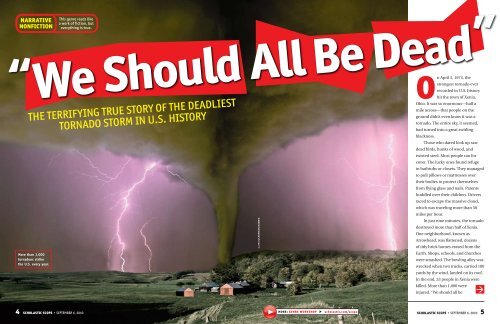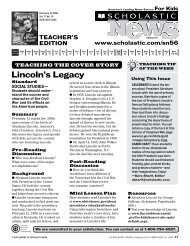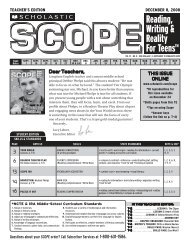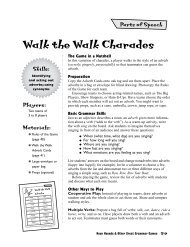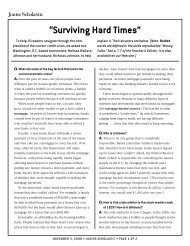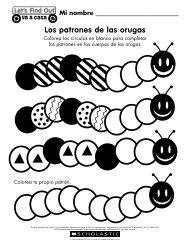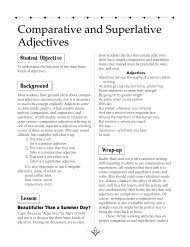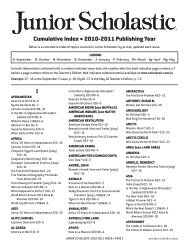NonFiction - Scholastic
NonFiction - Scholastic
NonFiction - Scholastic
Create successful ePaper yourself
Turn your PDF publications into a flip-book with our unique Google optimized e-Paper software.
<strong>NonFiction</strong><br />
Narrative<br />
nonfiction<br />
“ We Should All Be Dead”<br />
The terrifying true story of the deadliest<br />
tornado storm in U.S. history<br />
More than 1,000<br />
tornadoes strike<br />
the U.S. every year.<br />
This genre reads like<br />
a work of fiction, but<br />
everything is true.<br />
©Jim Zuckerman/Corbis<br />
On April 3, 1974, the<br />
strongest tornado ever<br />
recorded in U.S. history<br />
hit the town of Xenia,<br />
Ohio. It was so enormous—half a<br />
mile across—that people on the<br />
ground didn’t even know it was a<br />
tornado. The entire sky, it seemed,<br />
had turned into a great swirling<br />
blackness.<br />
Those who dared look up saw<br />
dead birds, hunks of wood, and<br />
twisted steel. Most people ran for<br />
cover. The lucky ones found refuge<br />
in bathtubs or closets. They managed<br />
to pull pillows or mattresses over<br />
their bodies to protect themselves<br />
from flying glass and nails. Parents<br />
huddled over their children. Drivers<br />
raced to escape the massive cloud,<br />
which was traveling more than 50<br />
miles per hour.<br />
In just nine minutes, the tornado<br />
destroyed more than half of Xenia.<br />
One neighborhood, known as<br />
Arrowhead, was flattened, dozens<br />
of tidy brick homes erased from the<br />
Earth. Shops, schools, and churches<br />
were smashed. The bowling alley was<br />
wrecked when two trucks, carried 100<br />
yards by the wind, landed on its roof.<br />
In the end, 33 people in Xenia were<br />
killed. More than 1,000 were<br />
injured. “We should all be <br />
4 <strong>Scholastic</strong> Scope • SEPTEMBER 6, 2010 more: GENRE WORKSHOP scholastic.com/scope<br />
<strong>Scholastic</strong> Scope • SEPTEMBER 6, 2010 5
Above: A massive tornado blackens the sky above Xenia,<br />
Ohio. RIGHT: The Super Outbreak was front-page news<br />
across the U.S. FAR Right: A scene of destruction in Xenia.<br />
dead,” wrote the editor of the town’s<br />
newspaper.<br />
In the hours after the tornado<br />
hit, few in Xenia knew their suffering<br />
was just one small part of a far bigger<br />
of Tornadoes: April 3-4, 1974<br />
disaster. In approximately 15 hours,<br />
VT NH<br />
148 tornadoes touched down in<br />
NY MA<br />
13 states. All were part of CT the same<br />
RI<br />
weather system PAthat cut a path of<br />
NJ<br />
destruction OH across MD2,500 DE miles.<br />
In Brandenburg, WV Washington, Kentucky, a<br />
VA D.C.<br />
tornado flattened three quarters of<br />
the buildings and NC killed 31 people.<br />
Farther north in Fountaintown,<br />
SC<br />
Indiana, a tornado picked up a<br />
GA<br />
metal warehouse and dropped it<br />
a mile away. In Jasper, Alabama,<br />
FL<br />
firefighters escaped from their<br />
station house just seconds before<br />
the building and all the fire trucks<br />
were destroyed. All along the storm’s<br />
path were similar scenes—stunned<br />
survivors standing in the rubble of<br />
their homes. By the time the skies<br />
SD<br />
NE<br />
KS<br />
OK<br />
TX<br />
148 Tornadoes in 15 Hours<br />
The Super Outbreak hit 13 states<br />
MN<br />
IA<br />
MO<br />
AR<br />
LA<br />
KEY<br />
State affected<br />
by a tornado<br />
WI<br />
IL<br />
MS<br />
IN<br />
MI<br />
TN<br />
AL<br />
KY<br />
OH<br />
Gulf of<br />
Mexico<br />
CANADA<br />
GA<br />
WV<br />
SC<br />
FL<br />
PA<br />
VA<br />
Scale: 0<br />
NC<br />
NY<br />
MD<br />
ATLANTIC<br />
OCEAN<br />
W<br />
NJ<br />
DE<br />
VT NH<br />
N<br />
S<br />
CT<br />
MA<br />
Washington,<br />
D.C.<br />
E<br />
200 MI<br />
RI<br />
Left to Right: ©AP Photo Images/Fred Stewart; The Granger Collection, NY; ©Bettmann/Corbis<br />
cleared, more than 315 people were<br />
dead and some 5,000 were injured.<br />
Out of the Ruins<br />
Forecasters working that April<br />
day knew that dangerous weather<br />
was simmering over the central U.S.<br />
Cold air was sweeping down from the<br />
Canadian Rockies. A mass of warm,<br />
wet air was blowing northward from<br />
the Gulf of Mexico. The collision<br />
of these two weather fronts would<br />
create the perfect conditions for a<br />
violent type of thunderstorm known<br />
as a “supercell.” These storms are<br />
dangerous on their own—with<br />
driving rain, booming thunder,<br />
lightning, and hailstones. Supercells<br />
are also the kinds of storms that<br />
produce the most severe tornadoes.<br />
But there were no tornado<br />
warnings in advance of what<br />
became known as the Tornado Super<br />
Outbreak. On April 3, the Xenia<br />
newspaper ran the daily forecast<br />
on its usual spot on page one.<br />
The National Weather Service had<br />
issued a “severe storm watch” from<br />
noon until 3 p.m. that day. “Severe<br />
thunderstorms with damaging<br />
winds” were predicted. There was<br />
no mention of tornadoes until the<br />
funnel cloud actually appeared in<br />
the sky. But by then, it was too late<br />
for most to escape to safety. As one<br />
Xenian survivor said, “All we could do<br />
was close our eyes and pray.”<br />
The reason there was no advance<br />
warning is simple: Tornadoes<br />
were not well-understood in 1974.<br />
The technology used by weather<br />
forecasters could not accurately<br />
detect tornadoes before they<br />
descended from the sky.<br />
Mr. Tornado<br />
After the Super Outbreak,<br />
scientists became determined to<br />
develop better ways of predicting<br />
tornadoes. Leading the effort was a<br />
professor of meteorology named<br />
T. Theodore Fujita. Dr. Fujita was<br />
already well-known among weather<br />
scientists. He had even earned the<br />
nickname “Mr. Tornado.”<br />
In 1971—three years before<br />
the outbreak—Fujita developed<br />
the Fujita Tornado Scale, a system<br />
that rated tornadoes on a scale of<br />
zero through five, according to how<br />
much damage they caused. An F-0<br />
tornado, the weakest, might snap<br />
branches off small trees. An F-5, the<br />
strongest, can obliterate an entire<br />
town. Before Fujita’s scale, scientists<br />
rated tornadoes by size, even<br />
though small tornadoes<br />
<br />
6 <strong>Scholastic</strong> Scope • SEPTEMBER 6, 2010 <strong>Scholastic</strong> Scope • SEPTEMBER 6, 2010 7
Tornadoes<br />
Up Close<br />
Today’s tornado<br />
researchers study<br />
storms up close.<br />
BELOW: “Mr. Tornado,”<br />
T. Theodore Fujita.<br />
RIGHT: This probe<br />
is released into a<br />
tornado to capture<br />
information like<br />
wind speed.<br />
could be more intense than larger<br />
ones. His system was more useful<br />
and far more accurate.<br />
After the outbreak, Fujita did a<br />
complete study of the damage. Flying<br />
low in a small plane, he surveyed<br />
the path of destruction over and<br />
over. He examined photographs and<br />
interviewed survivors. Fujita had a<br />
special talent for “reading” a disaster<br />
area—finding the patterns of fallen<br />
trees, the scruff left in a corn field, the<br />
spray of wood from a flattened house.<br />
Using these patterns, he created<br />
detailed pictures of all 148 tornadoes.<br />
Fujita determined that the Xenia<br />
tornado had winds far stronger than<br />
anything ever recorded—more than<br />
300 miles per hour. (The destructive<br />
winds of Hurricane Katrina in<br />
2005, by contrast, were 140 mph.)<br />
He proved that tornadoes could<br />
occur almost anywhere; one had<br />
even climbed up a mountain in<br />
Kentucky. The most shocking thing<br />
he discovered was that tornadoes can<br />
have more than one “suction vortex.”<br />
This means that some tornadoes<br />
contain two or three smaller<br />
tornadoes inside one swirling cloud.<br />
Thanks to the effort Fujita<br />
led, the United States government<br />
has improved the system for<br />
tracking dangerous storms. Today,<br />
meteorologists in more than 120<br />
national weather stations monitor<br />
storms as they develop. They use a<br />
system called “Doppler radar,” which<br />
helps forecasters predict tornadoes<br />
with an 80 percent success rate.<br />
In the 1970s, people often had<br />
less than one minute to prepare for a<br />
tornado. Now, the average “lead time”<br />
between warning and impact is 12<br />
to 14 minutes. For many, that is the<br />
difference between finding shelter<br />
and not—between life and death.<br />
Rush of Horrifying Winds<br />
Every year, an average of 1,000<br />
tornadoes strike the United States.<br />
The middle of the country—the<br />
Dakotas, Nebraska, Kansas,<br />
Oklahoma, Western Texas, and<br />
Eastern Colorado—is nicknamed<br />
©Jim Reed/Corbis; INSET: University of Chicago Archive<br />
Left: ©Peter Yost/National Geographic HT; Right: ©Eric Nguyen/Corbis<br />
“Tornado Alley” because it’s the most<br />
tornado-prone area. Few experts<br />
think another Super Outbreak will<br />
happen during this century. But for<br />
those who survived, the memories<br />
echo like those thundering winds.<br />
Vicki Gamble was just 4 years old<br />
when the tornado hit her Arrowhead<br />
neighborhood in Xenia. Decades<br />
later, she remembers every minute<br />
of that day—riding her tricycle in her<br />
driveway, how kids were laughing in<br />
the street. “It was a picture-perfect<br />
day,” she recalls, until neighbors<br />
began running down the street<br />
screaming, “Tornado! Tornado!”<br />
Her father gathered Vicki, her<br />
mother, and brother into a hallway<br />
and put a mattress over them. After<br />
checking on a neighbor, he crawled<br />
An average tornado<br />
is 600 feet<br />
wide —the width<br />
of four football fields.<br />
More<br />
tornadoes<br />
happen in<br />
the u.s.<br />
than in any other<br />
country on Earth.<br />
Write to Win!<br />
Tornadoes have<br />
no color at first.<br />
They darken as they fill<br />
with dirt, dust, and debris.<br />
Winds can top<br />
300 mph, more<br />
than twice as fast as<br />
in a severe hurricane.<br />
under the mattress with his family,<br />
The Xenia Daily Gazette won a Pulitzer<br />
laying his body on top of them.<br />
Prize for its coverage of the Super<br />
There was a moment of eerie quiet.<br />
Tornado Outbreak. Imagine that you<br />
And then “a rush of horrifying winds<br />
are a journalist for the Gazette, and<br />
seemed to be tearing our roof off.”<br />
interviewed Vicki Gamble about what<br />
When the family finally crawled out<br />
happened. Then use details from this<br />
of their hiding place, their house was<br />
article, as well as your “interview,” to<br />
still standing. But the neighborhood<br />
write a news story about the outbreak.<br />
outside their window was gone.<br />
Mail it to “Scope Tornado Contest”<br />
“A tornado devastated my town<br />
Jim Murphy is one of our<br />
by October 15, 2010. We’ll send 10<br />
that afternoon,” she wrote in an<br />
favorite writers of narrative<br />
winners a copy of Jim Murphy’s Truce. nonfiction. He has won many<br />
article 32 years later. “It became a day<br />
See page 2 for mailing details.<br />
awards. This is his latest book.<br />
that I have not forgotten.” •<br />
8 <strong>Scholastic</strong> Scope • SEPTEMBER 6, 2010 <strong>Scholastic</strong> Scope • SEPTEMBER 6, 2010 9


